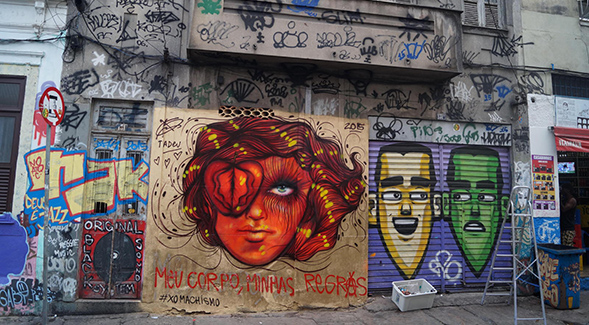International Collaborative Course Takes Inspiration from the Streets
Students will exchange ideas with their counterparts at a school in Bogot.

Students from SDSU and Universidad Católica de Colombia (UCC) will exchange ideas through shared coursework and group projects in the Collaborative Online International Learning (COIL) course, a popular form of global, cross-cultural learning that doesn’t require travel abroad.
Artistic Interventions in South American Streets (BRAZ 496 and ANTHRO 529), is new for fall 2021 at SDSU and will be taught by Kristal Bivona, assistant director and lecturer in the Behner Stiefel Center for Brazilian Studies.
Bivona said her course takes an interdisciplinary approach to examining street art, public art, artistic manifestations of protest, performance, and other forms of artmaking and exhibiting in the Latin American cities of Rio de Janeiro, São Paulo, Belo Horizonte, and Salvador in Brazil, and Bogotá and Medellín, Colombia.
“The course will draw on theory from urban anthropology to ground our understanding of the intersection of art and the city,” said Bivona. “In the second half of the semester, we’ll be ‘COILing’ with faculty and students who are taking a course on urban photography from the School of Architecture and Design" at the Colombian university.
Students will gain an understanding of cultural and disciplinary contexts as they exchange creative ideas with their counterparts from the other country. Students will compare and contrast diverse ways of seeing the city, and develop a creative project that accounts for seeing the city as a photographer and as a humanist.
“My colleague at UCC, Marcelo Mejía, is a world-renowned muralist and we’ve collaborated on street art projects in the U.S. and Bogotá in the past, so I’m really happy to co-teach with him,” Bivona said.
Mejía, an architect, holds an MFA in plastic arts and a graduate certificate in photography from the Universidad Nacional de Colombia and teaches courses in architecture, design, and photography for the School of Architecture and Design.
Prior to the fall roll-out of the course, Bivona and Mejía attended the State University of New York’s COIL Design workshop with support from International Affairs to gain more details about how students will work together. Bivona envisions selecting common texts to assign so that students can work from a shared vocabulary in order to achieve a baseline conceptual understanding of one another.
The course is offered in English and Spanish; students can speak whatever language they feel most comfortable in. “We will make it a point to make it a place where everyone can understand what is going on,” Bivona said.
Both graduate and undergraduate students are invited to enroll.
“My hope is that students, in addition to what they learn, will discover deep connections with their peers and possibly travel to meet one another sometime in the future,” Bivona said. “I hope it inspires them to study abroad.”



